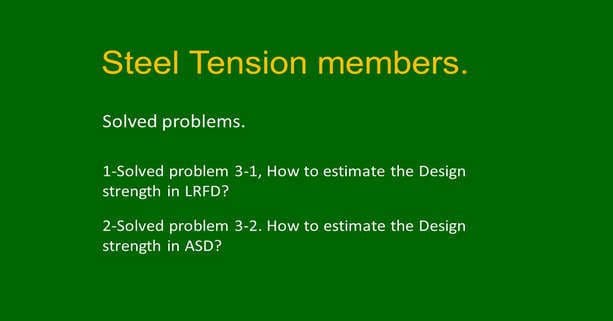Last Updated on April 27, 2024 by Maged kamel
How to estimate the nominal and design strength of a bolted plate, under tension force?
Solved problem 3-1 for nominal strength.
Brief description of the tensile strength and yielding formulas for tension members.
The next slide contains the same known information used as a reference, for tensile yielding, the parameter φt=0.90, to be multiplied by Pn. So, φt * Pn=φt*fy*Ag=0.90 Fy*Ag was for the LRFD nominal tensile strength.
While for ASD use the equation Pn/Ωt =Ag*Fy/Ωt.
If dealing with the net area, we can estimate by using the vertical section or using the zigzag line, then the selected net area is the lesser value of the net area considered for possible all sections, nominal load Pn=fult*Aeff.
Where Ae=Anet. when U=1 as in the case of the plate. Our φt will be reduced will be=0.75*φt*Pn= φt*Fult*Aeff, LRFD. While for ASD, Pn/Ωt = fult*Aeff /Ωt, where Ωt=2.0. These are the Equations used for the Limit state of yielding and limit state of rupture.

This is the related yield stress and tensile stresses for different types of ASTMs.
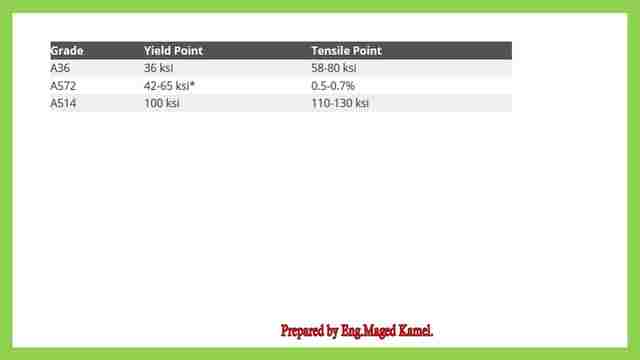
This is table 2-5 for the applicable ASTM A-table 2-6 specification for plates and bars.
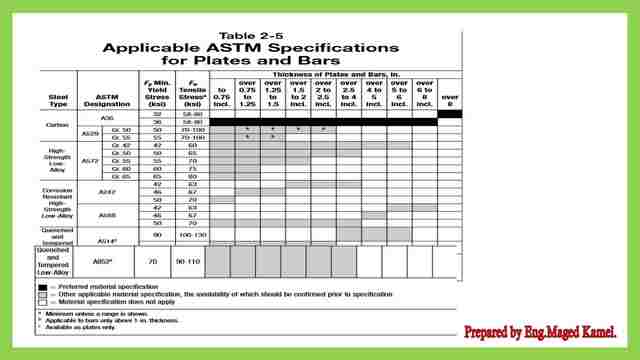
This explains the definitions of the pitch distance S and g, the gauge line distance.

A Solved problem 3-1.
This is the solved problem 3-1; we have a plate of 1/2 inch and width of 5 inches, of A36, and is used as a tension member, as a part of a truss, for example, as a bottom chord subjected to a tension force, it is connected to a gusset plate with four 5/8 inch, as shown in fig 3-3.
Assume that the effective net area-Aeff = the actual Anet, and the computation of the effective net area will be dealt with later.
It is required to find the following:
1- What is the design strength of LRFD?
2- What is the allowable strength for ASD?
LRFD calculation for design strength.
The steps for the solution of the solved problem 3-1 are as follows:
1-Check the value Fy whether 36 ksi, or less, we will check Table, 2-5, for plates, the width of the plate does not exceed 8″, so it is preferred to consider Fy as =36 ksi and fult=58.0 ksi.
2- Estimate the gross area, we have a width=5″ and thickness of 1/2″ Gross area= Ag=5*1/2=2.50 inch2.
3- Add 1/8″ to the bolt diameter to account for punching and damages, so the diameter of the hole=5/8+1/8=6/8″.
4- for Anet calculation, it is =Agross-sum(d)*t=2.50-2*(6/8*1/2)=1.75 inch2.
5-For failure due to yielding, we can estimate the Nominal tensile strength=AgFy=2.536=90.0 kips. 6-LRFD tensile strength as φtAgfy = 0.902.5036= 81.0 kips, strength due to yielding.

6- The tensile strength due to rupture=AnFult=1.7558=101.50 kips.
7-LRFD tensile strength as φtAgfy = 0.75*101.5=76.125 kips, strength due to rupture.
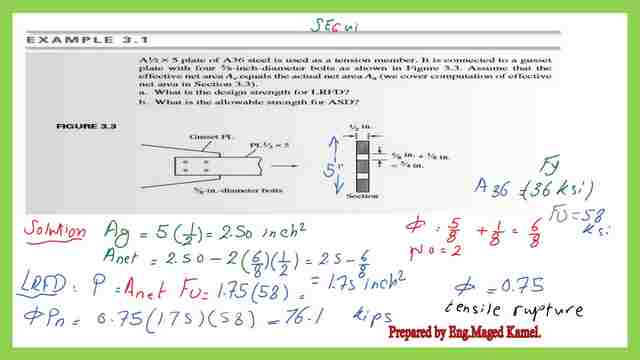
8- select the minimum value for the final LRFD value= min(90,76)=76.0 kips, this value will be the strength design.
ASD calculation for design strength.
Two cases to be considered. The first one is failure due to yield, Ωt=1.67. The second case failure is due to fracture where Ωt=2.00.
Always φt*Ωt=1.50.
First case failure due to yielding.
We can estimate the ASD tensile strength as (1/Ωt)*Ag*fy = (1/1.67)*2.50*36= 60 kips for yielding.
First case failure due to yielding.
We can estimate the ASD tensile strength as (1/Ω)t*An*fult = (1/2)*(1.75)*58= 50.80 kips for rupture.
For the minimum value for ASD, we will take the minimum value of (60,50.80)=50.80 kips, the final solution for solved problem 3-1. The allowable service load is the smaller value.
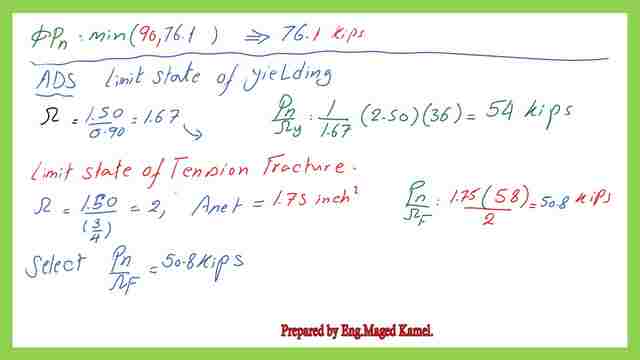
The next post is: What are workable Gauge Lines? The post is an introduction to the workable gauges for angles.
For a good reference–Types of tension members in structural steel construction.

